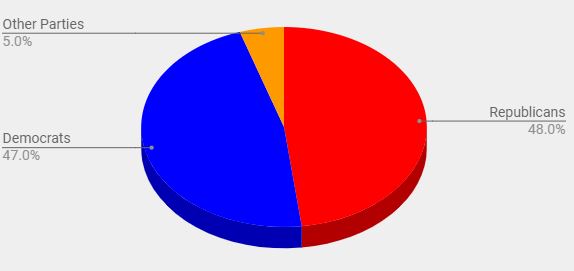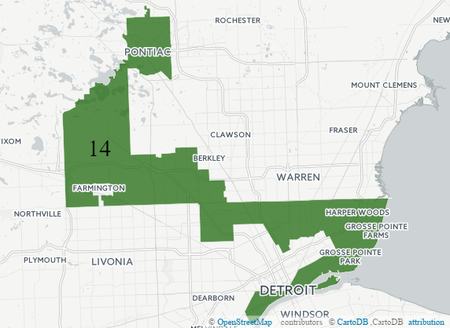How “Red” or “Blue” are Michigan’s Political Maps and Election Results? [CHARTS]
Analyses of 2016 election results show Republicans won higher percentages of seats than votes.

Do Michigan’s political maps give Republicans an unfair advantage in elections because of how the voting districts are drawn?
It’s a question some political analysts have been trying to answer since last November.
Bridge Magazine and the Associated Press each reviewed the results of 2016 races for Congress and the Michigan Legislature. Each study drew the same conclusion: Republicans won a much larger percentage of seats than total votes. For example, 48 percent of voters in Michigan’s 14 U.S. House races chose GOP candidates, while 47 percent voted for Democrats. Yet Republicans won nine seats.
This interactive chart illustrates the difference:
Source: Michigan Secretary of State, official election results
The next chart shows similar results in state legislative races. Democrats edged Republicans in total votes cast, but the GOP won most of the seats.
Source: Michigan Secretary of State, official election results
Note: There were special elections to fill partial terms in Districts 11 and 28. Democrats retained these seats and also won full terms starting Jan. 1, 2017.
And the difference between votes won and seats won was even wider in the 2014 state Senate elections:
Source: Michigan Secretary of State, official election results
Note: There was a special election in Nov. 2016 to fill a vacancy in state Senate District 4. The Democratic Party retained the seat.
The results do not surprise Dave Daley, author of “Ratf**ked: The True Story Behind the Secret Plan to Steal America’s Democracy“. In the book, Daley argues that these gaps are the result of gerrymandering.
“Republicans have this powerful advantage because Republicans drew the lines that way to build themselves a legislative majority even in years when their candidates receive fewer votes,” Daley writes in the newly-published epilogue to his book.
Click here for WDET’s 2016 interview with Daley.
In Michigan, Daley says, Democrats won a majority of state House seats and a majority of votes in 2008. After Republicans retook the House in 2010, they used U.S. Census data to draw new district boundaries. GOP candidates have maintained their majority in three elections since then.
“It’s just additional proof that gerrymandering matters more than geography; these Democrats did not self-sort themselves into like-minded communities between Election Day 2008 and 2012.” — Dave Daley
Since writing the book, Daley has moved on from his job as editor-in-chief at Salon to a fellowship at FairVote, a nonpartisan election reform group. He tells WDET’s Pat Batcheller GOP-led redistricting has made legislative races much less competitive across the board. By putting more Republican voters in “red” districts, and more Democrats in “blue” ones, Daley says most seats are safe for both parties. He also says that makes the chances of one party “flipping” a seat slim.
“There’s only about 25 swing seats (for Congress) … left in the country,” Daley says.
WDET’s partner in the Detroit Journalism Cooperative Bridge Magazine shows just how safe most seats are in Lansing. These maps illustrate the decisive edge that winners from both parties have in the Michigan Legislature:
State House:
Republicans hold a 63-47 advantage in the Michigan House, which is the least imbalanced of the three bodies, according to efficiency gap methodology. Still, Democratic candidates tended to win by larger margins than Republicans. Click a district to see the results or type in your address or ZIP Code to see how the results of your district.
State Senate
Click a district to see the results or type in your address or ZIP Code to see how the results of your district.
The Michigan Senate is the most imbalanced of all legislative bodies in Michigan, according to “efficiency gap” methodology. In 2014, Republicans won 27 seats compared to 11 for Democrats. The GOP typically won their races by tighter margins, while the Dems captured safe seats in blowouts.
One seat that has been safely Democratic for decades is the one held by Rep. John Conyers, currently the U.S. House’s longest-serving member. He won his 27th term in November 2106 with 77 percent of the vote in Michigan’s 13th District. His Republican challenger, Jeff Gorman, took 15 percent. Conyers is one of two African-Americans in Michigan’s congressional delegation. The other is Rep. Brenda Lawrence, who represents the 14th District. She beat her GOP challenger, Howard Klausner, by a similar margin (78 to 18 percent). Daley points to Lawrence’s district as a prime example of gerrymandering. It covers parts of Detroit, Southfield, and Pontiac, which all have large African-American populations.

Daley says drawing districts such as Michigan’s 14th is part of the Republican Party’s strategy of weakening Democratic votes. He says the GOP has used its majorities in Michigan and other states to pass new laws aimed at restricting minority voters, who tend to vote for Democrats.
“Whether that’s through voter ID laws, whether that’s through changing rules on absentee balloting or early voting, or any of the other techniques,” Daley says.
How’s Detroit doing when it comes to redistricting?
Democrats still dominate the city’s politics. All of its representatives in Lansing and Washington are Democrats, and most are African-American. Daley says redistricting has made politics — and politicians — more partisan and less willing to work together. Unless that changes, Democrats who represent Detroit face a difficult time shaping policies that could affect the city directly.
Click on the audio player above to hear the conversation.
